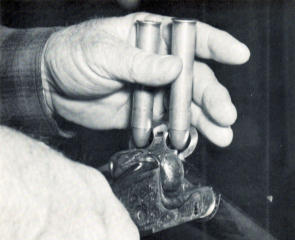03 July 2006, 06:03
400 Nitro ExpressSolids in Doubles
Gerard:
Spoken like a man with something to sell.
------------------------------------------------
"Serious rifles have two barrels, everything else just burns gunpowder."
03 July 2006, 09:35
BigFiveJackMust we get a physics PHd holder to run tests on this subject of G S Custom Bullets and their safe usability in old and new double rifles?
Any college professors out there who can "hook us up"?
03 July 2006, 23:43
MacD37quote:
Originally posted by Gerard:
When considering how hard or soft a bullet will be on a barrel, there are some important factors to take into account.
Monometal bullets are more difficult to compress lengthwise as well as radially than jacketed lead core bullets. This means that both are relatively high in the generation of barrel wall pressure. With the monometal bullet because most are made from bronze and it takes a lot of pressure to engrave the full length of the bearing surface. With the jacketed bullet because it compresses lengthwise under pressure of acceleration and climbing chamber pressure. This causes it to try and expand radially, thereby increasing barrel wall pressure. Take your pick which one you want to gamble with.
A solid copper bullet with drive bands will resist lengthwise compression under pressure and it rides on the faces of the lands with only the drive bands being engraved by the rifling. It exerts the lowest barrel wall pressure of all bullet types and results in the least heat and friction being generated within the bore. It is logical that, if heat and friction is reduced and barrel wall pressure is reduced, the barrel must be less stressed with each shot fired. It does not matter when the barrel was made and what it is made from. A true drive band bullet (grooved bullets excluded), made from copper, will always be easiest on any barrel.
Now! Gentlemen, those are words you can take to the bank!

PRO, or CON, my opinion is, the only mono-metal bullet that is safe in a double rifle is one with driveing bands that are slightly larger dia that the GROUVE dia of your barrel, and the shank of the bullet just bore dia. I believe copper is best, but if properly made, bronze is fine as well.
As far as the idea that either softs, or solids are somehow not needed in a double rifle, that is rediculous. The first shot out on my double is always a soft, followed by solids, UNLESS I'm useing the NF cups, then they will be first, and last with all NF cups in between! That is my opinion, take it or leave it, but the price is right either way!

08 July 2006, 13:20
Gerard400 Nitro Express,
I ran tests with a 220 Swift in 1996 when we were in the final stages of our patent application. I used commercially available 50gr ammunition that chonographed at an average of 4010fps. After measuring the temperature of the cleaned, unfired rifle at the barrel receiver joint, we proceeded to fire shots at 30 second intervals. After nine shots the temperature reached 74 degrees C and I decided not to continue. The rifle was set aside to cool and then it was cleaned. Once the temperature of the rifle had dropped to the same as at the start of the test, we again commenced firing at 30 second intervals, but this time with 40gr HV bullets loaded to 4400fps. A temperature of 73 degrees was recorded after shot 34 and we stopped firing. A measurement of 78 degrees was recorded one minute later, after which the temperature started dropping again.
In the late 80s, LIW (Later Denel, builders of the
G6 Howitzer ,
Rooivalk and other military equipment) conducted testing on behalf of PMP Ammunition and found that the bulge measured on the outside of the barrel, that accompanies a bullet in it's passage down the bore, was the same size regardless of whether the bullet was a jacketed lead core bullet or made from bronze. The tests were conducted as part of the development process for PMP soft and solid ammunition for the 375 H&H. They concluded that, due to the resistance to linear compression of bronze solids, there was no material difference between that type of construction and copper clad lead core bullets.
If that sounds like I have more stuff to sell, it cannot be helped. Manufacturers of non drive band bullets are not going to tell you, are they?

